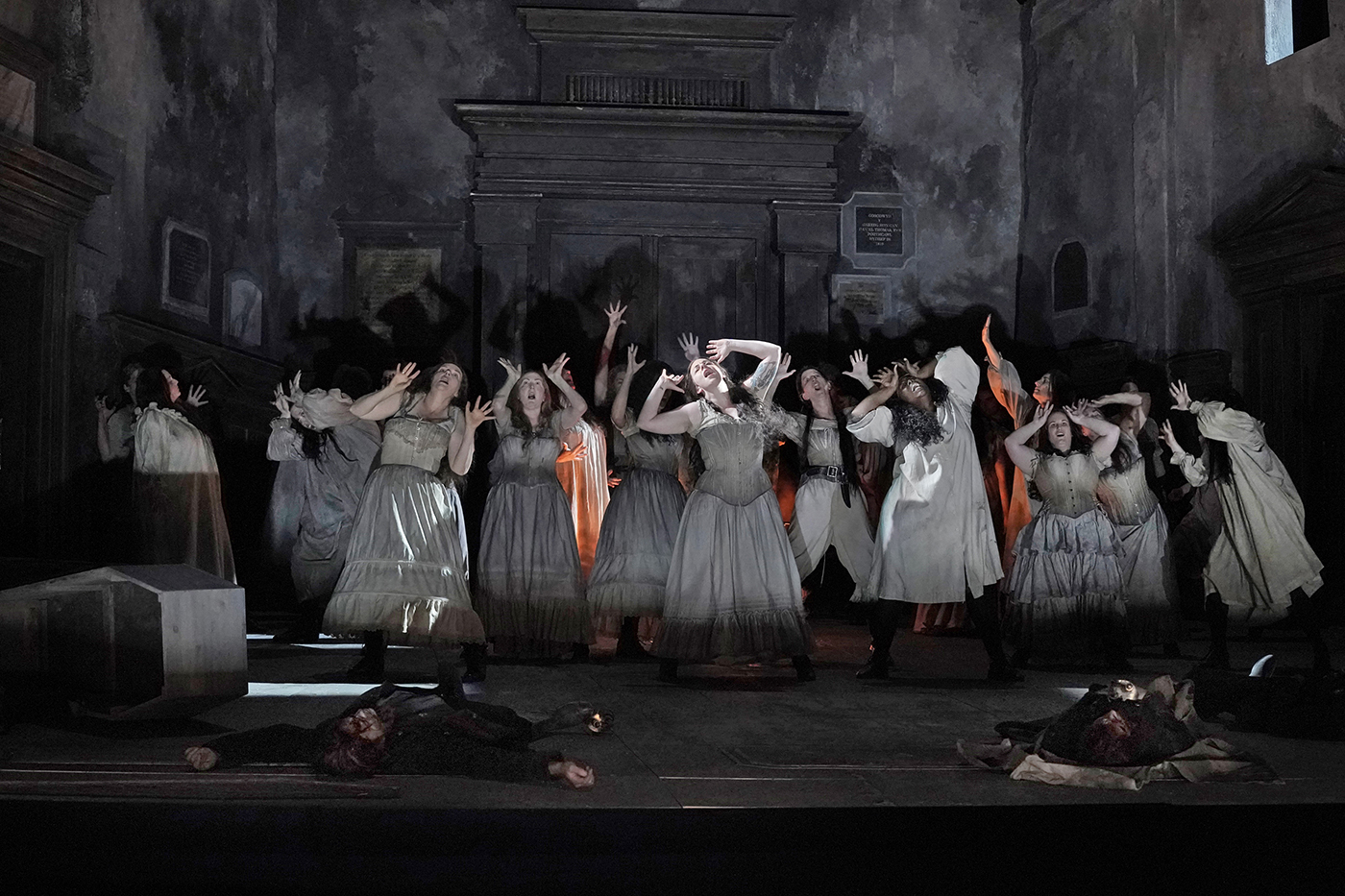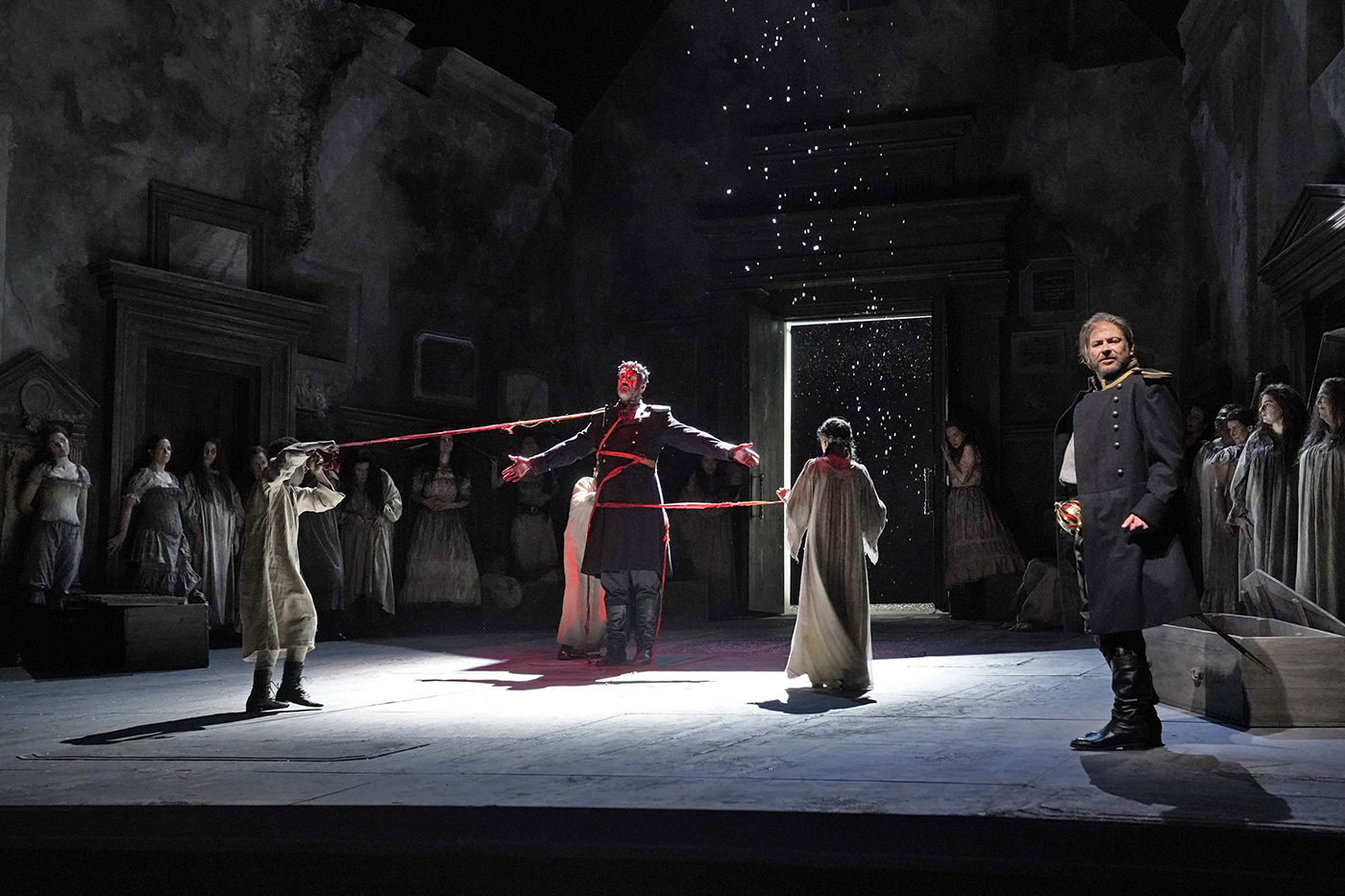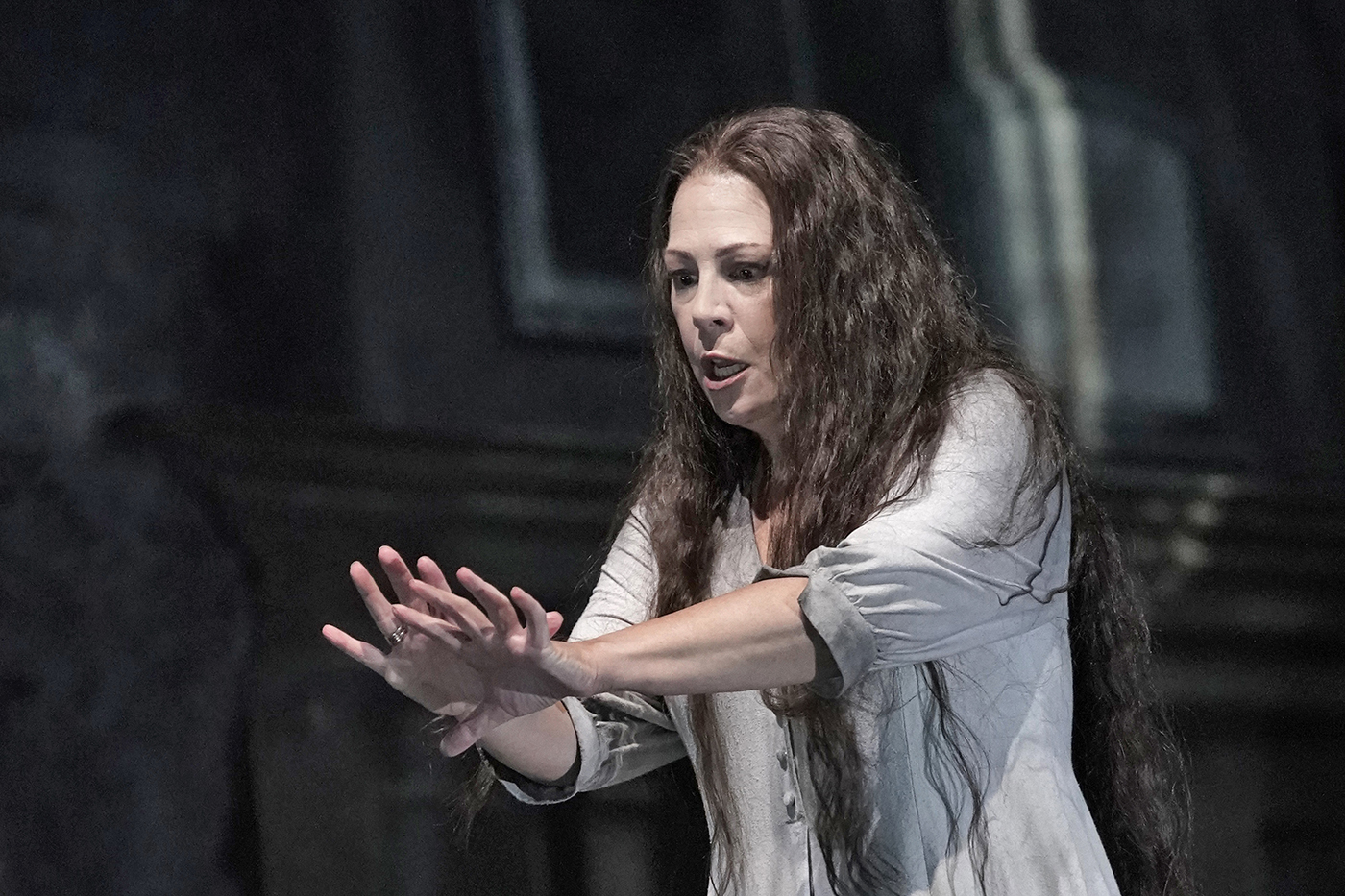September 12, 2021
A cloistered Macbeth
For an opera so steeped in foggy highlands that its source material is known to superstitious theater insiders as “the Scottish play,” Lyric Opera of Chicago tapped two proud Scotsmen, Sir David McVicar and John Macfarlane, to create a new production to spark the 2021/22 season — Lyric’s return to live mainstage performance after 18 months dark. The duo’s vision for the opera keeps the action in Scotland, but changes the historical time period and restricts the setting to a ruined Presbyterian chapel.
Director McVicar and set designer Macfarlane have not situated Lyric’s new Macbeth in the eleventh century of the historical Macbeth, who had little to do with Shakespeare’s tragedy, anyway. Nor did they choose the early seventeenth century, which was when Shakespeare’s play premiered near the start of the reign of James I, who ascended to the unified throne of England and Scotland in middle age after reigning in Scotland from toddlerhood. Instead, McVicar and Macfarlane have placed the production in the mid-nineteenth century — a Scotland that is contemporaneous with Verdi’s revised Macbeth. Lyric is performing the 1865 score, called the “Paris revision” because of its debut at the Théâtre Lyrique in Paris (the original version premiered in 1847).

The Witches' Sabbath in Lyric's 2021/22 production of Verdi's Macbeth, performed by members of the Lyric Opera Chorus.
The Presbyterian chapel serves as the setting for all scenes in this production; even the witches’ Sabbath heretically takes place within the sacred walls. The banquet scene, during which Macbeth and Lady Macbeth invite the noble thanes of Scotland to extol Macbeth’s reign, shows the church as a community space. At the close of the opera, it serves as the last redoubt for Macbeth against the advancing army camouflaged with the boughs of Birnam Wood.
A church is a place of good and evil, legend and myth, and a place to impart lore and morality. Centering this production in the chapel signals moral instability, as the witches practice dark arts within its walls. Macbeth strides into a roiling, vibrating tension created by these dichotomies, and drawn downward by his political ambition — with his wife egging him on — makes his (im)moral choices. All suffer the consequences.
The chapel space is modified throughout the production to indicate scene changes or reorient the audience’s perspective. In the opera’s opening, the prophesying witches sit in the pews, facing the house. For Act II, the church is turned around so that viewers face the altar to hear the Macbeths plotting Banquo’s murder. The furniture is reset for a banquet, then placed in disarray for the witches’ Sabbath, then cleared away entirely. A wall is removed for the final act, which allows the audience to see Malcolm’s advancing army on the horizon amid a fiery backdrop, hand-painted by Macfarlane. Macfarlane, an accomplished artist who regularly shows in U.K. galleries, painted the backdrops and the front curtain.
The single-location conceit of the staging means shunning many typical Macbeth trappings. There are no lavish castles, witchy caves, or desperate heaths. For the feast scene, the meager decorations added to the space — smallish portraits, a few pennants — situate the celebration as more of a dreary church tea than a magnificent meal. Instead of the standard alternation between gloomy, sinister milieus and royal grandeur, the aesthetic is uniformly stark.
The chapel setting, a conduit with the divine, amplifies the story’s prominent supernatural elements, particularly in Act III when apparitions foretell Macbeth’s future and witches sing and dance around a cauldron that rises out of the floor. The women of the community return to practice witchcraft, diabolically distorting the sacredness of the space. The pews become coffins and the dead, buried in a crypt beneath the church, rise. Corpses spring to life, holding candles as in Scottish poet Robert Burns’s “Tam O’ Shanter:” “Coffins stood round like open presses, / That shaw’d the dead in their last dresses; / And by some devilish cantraip sleight / Each in its cauld hand held a light.” (Cantraip means “a witch’s trick or mischievous device”). Playing out in the dim, claustrophobic, holy space, where the world outside the walls is completely dark, horror develops in the suggestibility of the audience’s imagination.
In keeping with the prevailing Romantic-era view, Verdi’s use of the supernatural, like Burns’s, isn’t merely spooky; Verdi’s witches sing jaunty, major-key music that emphasizes the comical and grotesque. McVicar says the nineteenth-century setting matches Verdi’s treatment of the phantasmagorical Scottish tradition, right down to a similar gathering at the climax of “Tam O’ Shanter,” which also takes place in a ruined church.

A ghoulish Banco (Ryan Opera Center alumnus Christian Van Horn) appears to Macbeth (Craig Colclough).
McVicar believes the Macbeths’ lust for power stems from their lack of children. In Shakespeare’s play, Lady Macbeth laments, “I have given suck, and know / How tender ‘tis to love the babe that milks me,” but the play provides no other evidence of this child. Children are prominently featured in this new production’s Walpurgisnacht-like display. One of the apparitions is a large, bloody, newborn child puppet. In one sequence, Lady Macbeth receives a Christmas gift from a brood of children: a tiny, baby-sized coffin. Birth, of course, pivots the warning that “No man that’s born of woman / Shall e’er have power upon thee;” Macbeth mistakenly believes no man can overthrow him, but in fact, Macduff, born by Cesarean section, or, as he puts it, “From his mother’s womb / Untimely ripp’d,” ultimately fells him.
Two Lady Macbeth scenes demonstrate the versatility of this production’s setting. When the church transforms into a celebratory space for the banquet scene, Lady Macbeth sings a drinking song — a brindisi — “Si colmi il calice” (“Fill the chalice”), that is an earlier iteration of Violetta’s famous brindisi “Libiamo, ne’ lieti calici” from Verdi’s La traviata. Connecting to the toast by way of red wine and red blood, Lady Macbeth sleepwalks through the empty church to sing “La macchia,” an aria about her inability to clean blood off her hands, the “Out! damnèd spot” of Shakespeare’s play. Here, the chapel is a space of confession and guilt.

Sondra Radvanovsky as Lady Macbeth during the iconic Act Four sleepwalking scene.
The costumes in the production, designed by Moritz Junge, pertain to the era of Verdi’s Paris revision. Macbeth appears in dress indebted to portraits of Prince Albert, Queen Victoria’s consort at Balmoral, the British royal family’s Scottish castle. Lady Macbeth wears layers of crinoline under lush, unadorned fabrics. Banquo’s military outfit is akin to an American Civil War uniform. Macduff is in full Highland dress, as is King Duncan — wearing the Duncan clan’s tartan pattern, of course. The chorus women in the Sabbath scene wear period undergarments such as shifts, corsets, and sarks.
The production also draws inspiration from memento mori photographs. In early photography, which aligns with the time in which this production is set, when a loved one passed away, relatives would dress the body up, pose it, and take a picture as a symbol of remembrance. The macabre tradition resonates with the bodies left in Macbeth’s wake; memories of the dead persist like the blood on Lady Macbeth’s hands.
No matter what era Macbeth is set or performed in, it offers a lens for current events. At the time of its premiere, King James I believed himself a descendant from the line of the historical Banquo, so Shakespeare may have used the prophecy that Banquo’s heirs would rule as a form of royal flattery. When the Paris revision premiered in 1865, Abraham Lincoln had been assassinated less than a week earlier.
Shakespeare and Verdi paint Macbeth with mythic brushstrokes, inviting patrons to see a historical template in the mayhem wrought by Macbeth’s ambition. “Macbeth’s tragedy is our tragedy,” McVicar says. Those hungry for power will always be with us, and some will inevitably turn to violence to acquire or sustain it, failing to recognize the mayhem is of their own making, as so happens with Macbeth in his last moments of introspection before the English forces reach him. Instead, he resorts to self-pity, seeing himself as a victim in a meaningless world, life as “...a tale / Told by an idiot, full of sound and fury / Signifying nothing.”
Now, as audience members return to Lyric after a hiatus imposed by a modern-day plague, the company hopes the Scottish play portends a future in which successions are smooth and the tragedy stays onstage. Let the trees march onward.
Graham Meyer covers classical music and other arts for publications such as Chicago magazine and Crain’s Chicago Business.
September 17 – October 9, 2021
Macbeth
Macbeth
Lyric’s riveting season opener is the inaugural production of Music Director Enrique Mazzola's tenure, and a brand-new production from Sir David McVicar. Adapting one of the greatest tragedies written by his hero, Shakespeare, Verdi created a stunning portrait of the most power-hungry couple who ever trod a stage. Macbeth’s bloody ascent to the throne of Scotland — led and supported by his wife’s own consuming ambition — results in disaster for them both. Verdi brings them to blazing life in a score that bristles with energy and endless excitement. Grand-scale arias, hair-raising duets, stupendous ensembles — they’re all here, in the first genuine masterpiece of Verdi’s career.

